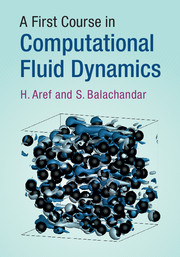Book contents
- Frontmatter
- Contents
- Preface
- 1 CFD in Perspective
- 2 Mappings
- 3 Ordinary Differential Equations: Initial Value Problem
- 4 Spatial Discretization
- 5 Boundary Value and Eigenvalue ODEs
- 6 Methods Based on Functional Expansions
- 7 Partial Differential Equations
- 8 Multi-dimensional Partial Differential Equations
- References
- Index
7 - Partial Differential Equations
Published online by Cambridge University Press: 03 October 2017
- Frontmatter
- Contents
- Preface
- 1 CFD in Perspective
- 2 Mappings
- 3 Ordinary Differential Equations: Initial Value Problem
- 4 Spatial Discretization
- 5 Boundary Value and Eigenvalue ODEs
- 6 Methods Based on Functional Expansions
- 7 Partial Differential Equations
- 8 Multi-dimensional Partial Differential Equations
- References
- Index
Summary
In this chapter we turn, finally, to subjects that are considered more mainstream CFD, viz., the variety of methods in use for discretizing partial differential equations (PDEs) on uniform grids in space and time, thus making them amenable to numerical computations. This is a very wide field on which many volumes have been (and will be) written. There are many different methods that have been advanced and promoted over the years. Many of the more well-established methods and schemes are named for their originators, although substantial leeway exists for improvements in detail and implementation. It is also not difficult to come away with feelings of helplessness and confusion concerning which method to choose and why. Our goal in this chapter will be to shed light on some of the guiding principles in constructing these methods.
A digression on semantics is in order. The words method and scheme are both in use for numerical procedures. It may be of interest to recall their precise meaning as given, for example, by The Merriam–Webster Dictionary:
Method: from the Greek meta (with) ' hodos (way).
(1) a procedure or process for achieving an end;
(2) orderly arrangement; plan.
Scheme
(1) a plan for doing something; esp. a crafty plot.
(2) a systematic design.
Although both these terms seem to apply for numerical procedures, it would seem from these definitions that the term method is somewhat more desirable than scheme! But we have used these terms interchangeably, perhaps with a slight emphasis on methods, and we will continue to do so.
Definitions and Preliminaries
Before we begin to consider numerical methods for PDEs, here we start by defining and classifying the PDEs that we wish to solve. In a PDE the quantity being solved, such as fluid velocity or temperature, is a function of multiple independent variables, such as time and space (t and x) or multiple space directions (x and y). As mathematical entities, PDEs come in many different forms with varying properties, and they are a very rich topic in their own right. Here we will stay focused on only those classes of PDEs that we generally encounter in fluid mechanical applications.
- Type
- Chapter
- Information
- A First Course in Computational Fluid Dynamics , pp. 244 - 292Publisher: Cambridge University PressPrint publication year: 2017

